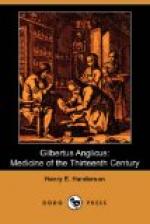When the wound of the scalp is small, so as to render difficult the determination of the extent of the fracture by exploration with the finger, it should be enlarged by crucial incisions, the flaps loosened from the cranium by a suitable scraper (rugine) and folded back out of the way, and any fragments of bone removed by the forceps (pinceolis). If, however, haemorrhage prevents the immediate removal of the fragments, this interference may be deferred for a day or two, until the bleeding has stopped or has been checked by suitable remedies. Then, after their removal, the piece of linen described above is to be inserted between the cranium and dura mater. Upon the cranium and over the flaps of the scalp, as well as in their angles, the ordinary dressing of albumen is to be applied, covered by a pledget of lint and a suitable bandage. No ointment, nor anything greasy, should be applied until after the healing of the wound, lest some of it may accidentally run down into the fracture and irritate the dura matter. Some surgeons, Gilbert tells us, insert in the place of the fragments of the cranium removed a piece of a cup (ciphi) or bowl (mazer), or a plate of gold, but this plan, he says, has been generally abandoned (dimittitur.)
Sometimes the cranium is simply cracked without any depression of the bone, and such fractures are not easily detected. Gilbert tells us, however, that if the patient will close firmly his mouth and nose and blow hard, the escape of air through the fissured bone will reveal the presence of the fracture (f. 88a). In the treatment of such fissures he directs that the scalp wound be enlarged, the cranium perforated very cautiously with a trepan (trepano) at each extremity of the fissure and the two openings then connected by a chisel (spata?), in order to enable the surgeon to remove the discharges by a delicate bit of silk or linen introduced with a feather. If a portion of the cranium is depressed so that it cannot be easily raised into position, suitable openings are to be made through the depressed bone in order to facilitate the free escape of the discharges.




